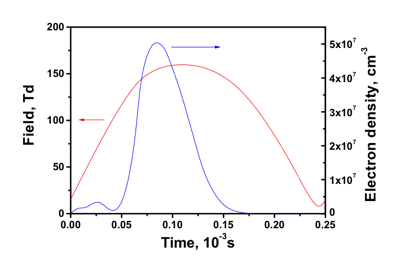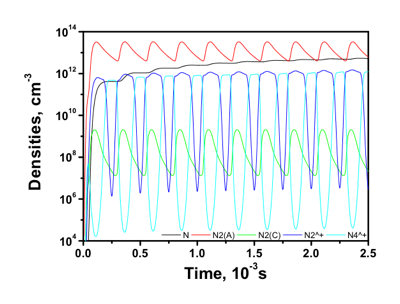Very often, a plasmachemical model in 0D approximation is not self-consistent and is only possible given certain assumptions. In the present test case we take the mean electric field and the electron density from experiment (see the Figure and external file data_in.dat. For example, they can be recalculated from measured gap voltage and discharge current density.
 This test case corresponds to a nitrogen plasma consisting of electrons, N2, N2(A), N2(B), N2(a’), N2(C), N, N+, N2+, N3+, N4+ and includes 36 processes. The BOLSIG+ solver is evoked to calculate the rates of excitation and ionization by electron impact. The reaction rates for heavy species are mostly taken from [1]. An effective ion-neutral collision temperature is calculated in this case using known electric field, mobilities and masses of species as it is proposed in [1].
This test case corresponds to a nitrogen plasma consisting of electrons, N2, N2(A), N2(B), N2(a’), N2(C), N, N+, N2+, N3+, N4+ and includes 36 processes. The BOLSIG+ solver is evoked to calculate the rates of excitation and ionization by electron impact. The reaction rates for heavy species are mostly taken from [1]. An effective ion-neutral collision temperature is calculated in this case using known electric field, mobilities and masses of species as it is proposed in [1].
 Corresponding lines are placed at the beginning of REACTION section in input text file kinet.inp. This input file is converted to a Fortran module using the PREPROCESSOR utility provided in the download package. An example of the Fortran code corresponding to above-mentioned kinet.inp file is zdplaskin_m.F90.
Corresponding lines are placed at the beginning of REACTION section in input text file kinet.inp. This input file is converted to a Fortran module using the PREPROCESSOR utility provided in the download package. An example of the Fortran code corresponding to above-mentioned kinet.inp file is zdplaskin_m.F90.
Requred cross sections for electron processes with species indicated in section BOLSIG have to be stored in bolsigdb.dat data file. In the present example, these electron cross sections were retrieved from ELECTRON SCATTERING DATABASE, SIGLO database.
A user code dbd0D.F90 reads the profiles of electric field and electrons from external file and computes evolution of densities during first 10 identical pulses. We note that the density of electrons is read from external file, so a call set_density(‘E’, LDENS_CONST = .true.) is used to do not make time integration of this species.
Data output file is out.dat, screen output is here – out.txt. You can download all these files in a zip archive.